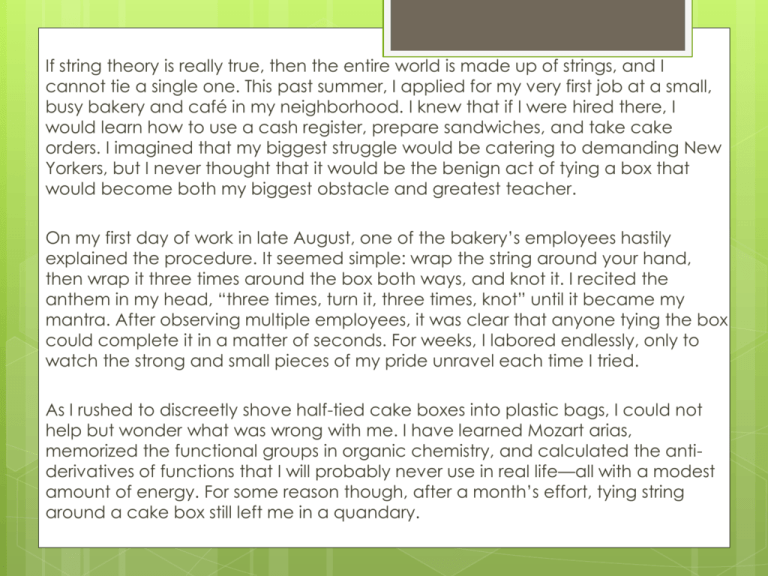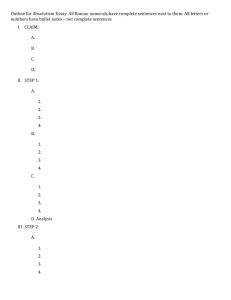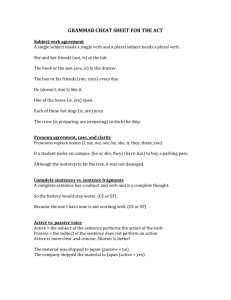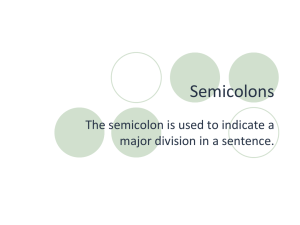Mechanics for Narrative Writing Powerpoint
advertisement

If string theory is really true, then the entire world is made up of strings, and I cannot tie a single one. This past summer, I applied for my very first job at a small, busy bakery and café in my neighborhood. I knew that if I were hired there, I would learn how to use a cash register, prepare sandwiches, and take cake orders. I imagined that my biggest struggle would be catering to demanding New Yorkers, but I never thought that it would be the benign act of tying a box that would become both my biggest obstacle and greatest teacher. On my first day of work in late August, one of the bakery’s employees hastily explained the procedure. It seemed simple: wrap the string around your hand, then wrap it three times around the box both ways, and knot it. I recited the anthem in my head, “three times, turn it, three times, knot” until it became my mantra. After observing multiple employees, it was clear that anyone tying the box could complete it in a matter of seconds. For weeks, I labored endlessly, only to watch the strong and small pieces of my pride unravel each time I tried. As I rushed to discreetly shove half-tied cake boxes into plastic bags, I could not help but wonder what was wrong with me. I have learned Mozart arias, memorized the functional groups in organic chemistry, and calculated the antiderivatives of functions that I will probably never use in real life—all with a modest amount of energy. For some reason though, after a month’s effort, tying string around a cake box still left me in a quandary. PRACTICE Go through your essay and circle language that is vague, generic, awkward, unclear, confusing, repetitive, slangy, clichéd, basic, or stale. Go back through your essay and replace these circled words with vivid vocabulary. Tips: Try adding dialogue Use sensory language (I heard, I felt, I smelled, I saw) Show, don’t tell Be descriptive – use vivid verbs Be specific, not vague Incorporate at least three different types of figurative language into your essay. HINT: Make sure your revisions don’t seem forced! Mechanics Review of Parallel Structure Correct the following sentences to make them parallel. Cross out any elements of the sentence that are not parallel and replace them with parallel elements. 1. When we go to Vegas we must go shopping, to the casino, and other entertainment places. 2. The teacher said that he was a poor student because he waited until the last minute to study for the exam, completed his lab problems in a careless manner, and his motivation was low. 3. The coach told the players that they should get a lot of sleep, that they should not eat too much, and to do some warm-up exercises before the game. 4. Dogs are great pets for the following reasons: they are loyal, they are loving and because of their obedience. Review of Parallel Structure You can also make whole sentences parallel. This can mean balancing two separate sentences or two sides of one sentence with the verb in the middle. Here are examples of both kinds: Let’s make a night you won’t remember; I’ll be the one you won’t forget. To know her is to love her. A Phrase is… A group of words that does NOT contain both a subject and a verb One or the other is missing A group of words that contains both a subject (noun) + a predicate (verb) …shouting out loud… …the blue marker… …once upon a time… …quickly running away… …because he was tired She ironed the shirt. While the wind howled… This is a complete sentence. Independent clauses Can stand alone as a complete sentence S + V My mom called today S Yesterday’s weather forecast V Dancing around the room S + V Where your textbook is S + V That computer is slow S + V Because you are working hard Dependent clauses Have both a subject and a verb CANNOT stand alone as a complete sentence S + V My mom called today S Yesterday’s weather forecast V Dancing around the room S + V Where your textbook is S +V That computer is slow S + V Because you are working hard Clause Practice Label each of the following clauses as Independent (I) or Dependent (D): 1. Jem and I confined our activities to the southern neighborhood 2. If she was on the porch when we passed 3. She was vicious 4. His money was burning up his pockets 5. But it was no help Using semicolons to separate clauses Semicolons can only be used to separate two independent clauses. Identify the sentence which correctly uses a semicolon to separate two complete sentences: A. Your mother was a hamster; and your father smelt of elderberries. B. If you drive me to the mall; I will buy you an ice cream cone. C. I would take you up on your offer; however, I don’t like ice cream. Add a semicolon to the following sentence to separate two complete sentences: The winter weather makes me want to move somewhere warm therefore I am looking for jobs in the South.











